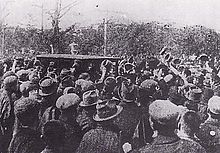Hibiya riots
The Hibiya riots ( Japanese 日 比 谷 焼 打 事件 , Hibiya yakiuchi jiken ) occurred on September 5, 1905 in Tokyo after the signing of the Treaty of Portsmouth , which sealed the end of the Russo-Japanese War . The Japanese public perceived the terms of the contract as humiliation. Japan, victorious on the battlefield, was only able to enforce a small part of its demands against the Russian negotiator Sergei Yulievich Witte . The fact that Russia should not pay any reparations was received with particular displeasure by most Japanese, as the costs of the war were enormous.
When the signing of the contract became known in Japan, various groups called for spontaneous protests . On the evening of September 5th, about 30,000 people gathered near Tokyo's Hibiya Park in Chiyoda . The police tried unsuccessfully to prevent the demonstration and blocked all entrances to the park. This led to civil war-like conditions in Tokyo, as a result of which at least 17 people were killed and more than 1,000 injured. The mob destroyed about 70 percent of the city's police buildings. After several hundred demonstrators were arrested in the following days, the situation initially calmed down. In the weeks and months that followed, there were repeated spontaneous riots by the population in Tokyo and other Japanese cities.
The event continues to mark the beginning of a series of violent rioting by the Japanese public that culminated in the 1918 rice riot .
literature
- Shumpei Okamoto: The emperor and the crowd: the historical significance of the Hibiya Riot. In: Tetsuo Najita, J. Victor Koschmann (Ed.): Conflict in Modern Japanese History. The Neglected Tradition. Princeton University Press, Princeton NJ 1982, ISBN 0-691-10137-X , pp. 258-275, (Eng.).
